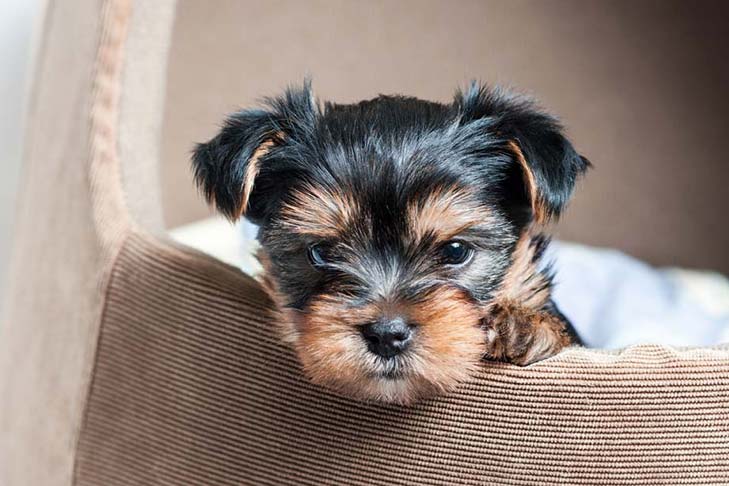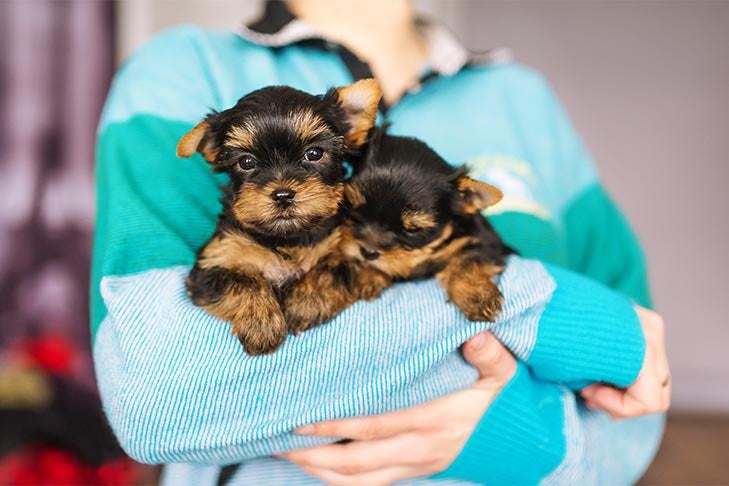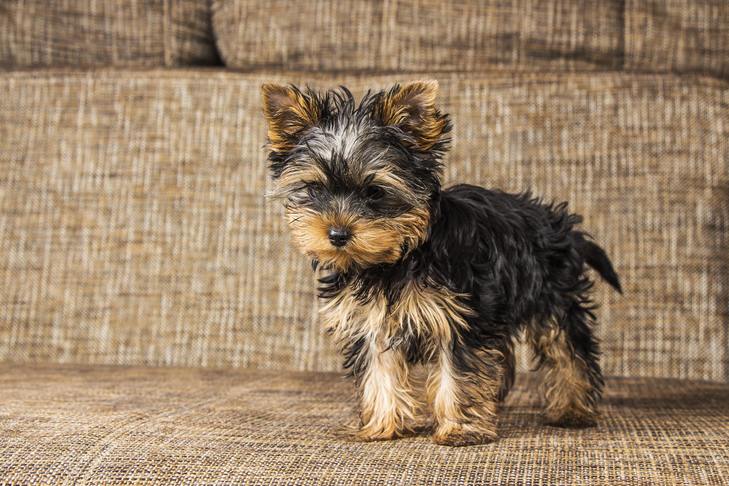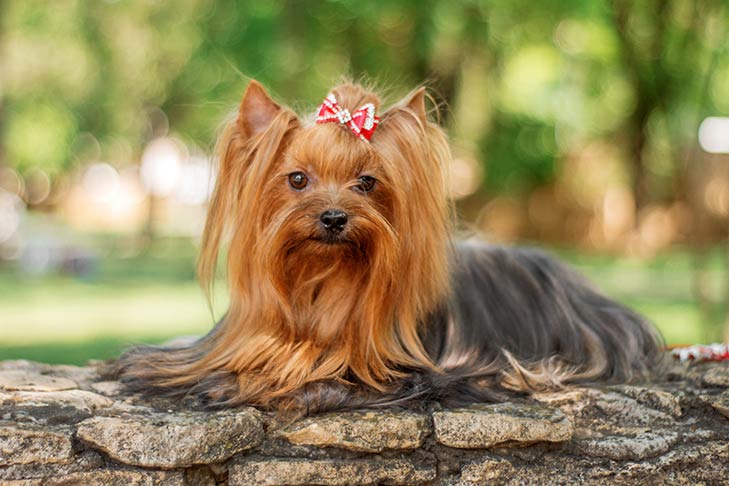
Getting ready to welcome a Yorkshire Terrier puppy into your home for the first time? Be prepared for that high Terrier energy and many important firsts in your young dog’s initial weeks, months, and year of life.
One of the most beloved and famous breeds of the toy group, Yorkies—known for their diminutive stature—require extra care compared to bigger dog breeds during this formative time, according to Judy Marksbury, a member of the the board of directors of the Yorkshire Terrier Club of America, a Yorkie breeder with over 30 years of experience, and owner of Happy Tails Pet Resort, which she has been running for over 24 years.
Here Marksbury shares the key milestones to look out for during Yorkie puppies’ first 12 months—including socialization, losing their puppy coat, the process of their coat changing color, and more.
Key Milestones, Weeks: 1-12
A Yorkie’s earliest weeks are the most important, says Marksbury. “At this time they learn how to be a puppy from their litter mates and their mother,” she explains. “That has to happen before they venture out in the world and become pets.”
That’s why it’s important that the earliest a puppy should be brought home is at 12 weeks, though many puppies remain with their litter, mother, and breeder until 16 weeks or longer, according to Marksbury. Removing a Yorkie from its first home too soon—earlier than 12 weeks—could lead to anxiety and eating problems, she explains.
Before your puppy first comes home between 12 to 16 weeks, you’ll need to puppy-proof your home (similar to baby-proofing.) Potential dangers to be on the look out for include extension cords, plants, and stairs—and find a vet so you’ll already be informed about where to take your dog in the event of an emergency, says Marksbury.

Weeks: 8-9
Around eight to nine weeks, Yorkie puppies are almost weaned, and that’s when breeders should take them to get their first puppy shots for parvo and distemper.
Weeks: 9-10
While Yorkie puppies are born with black and tan coloring, this will change over your dog’s first two years of life. Starting around nine to 10 weeks, the first sign of silver or gold should start to appear on the top of a Yorkie’s head.
Weeks: 12-16
Three weeks after their initial vaccinations—at around 12 weeks, Yorkie puppies will be ready for a repeat of their parvo and distemper shots and around this time they should also be checked for stool samples for parasites and have a complete physical, explains Marksbury.
All of this should be taken care of before they are placed in a new home, and you should get a health certificate with details about your Yorkie puppy’s overall condition from your breeder.
During your puppy’s first week with you at home, the goal is to ensure a smooth transition from the breeder to your house. Make sure you have plenty of time to be with your puppy at home, so they feel comfortable and have time to bond with your family. In other words, don’t plan on getting a puppy one day and going to a full day of work the next, explains Marksbury. Another thing to keep in mind is that this should be a relaxing time. “Don’t take them everywhere the first week,” she says, explaining that your puppy should first get comfortable at home with your family. “Gradually take them out. Go slow. Don’t overwhelm them.”
Use this time to teach your puppy how to walk on a lead, and importantly for Yorkies, be prepared to use a harness, which is better for their small size than a collar. Learning how to walk on a leash usually takes about a week. Marksbury suggests using positive reinforcements, such as offering treats like Cheerios or shredded cheese, to encourage them to pick up the skill. She also warns that humans should be prepared to see Yorkies display their fighter instinct when they first see bigger dogs out on a walk.
“They don’t know they’re little,” she explains. “They think they’re huge. If they see a big dog, they’ll try to go after them. They’re a small package but they don’t think they are. That’s the Terrier in them.”
This should be a learning opportunity to correct the behavior early on.
Before it’s time to go back to work or go out of the house for an extended period of time, figure out where you’ll be able to safely leave your puppy unattended—whether that’s a crate or closed off room where they won’t be able to get into anything dangerous.
“Never leave a tiny Yorkie in a backyard unattended,” says Marksbury, warning that, as small dogs, they’re more susceptible to being taken by predators (like hawks or coyotes) and are more sensitive to inclement weather, both hot and cold extremes.

Key Milestones, Weeks: 16-20
Week: 16
Around this time, a Yorkie’s color transition from black and tan to silver or gold may continue to progress—with the dark black color fading on the top of their back to a grey or light silver.
Weeks: 16-20
Between 16 to 20 weeks is also around the time your puppy will begin losing their thick, fuzzy puppy coat (called “felting”). “They look like they have hardly any hair” at this time, says Marksbury.
Expect your Yorkie’s adult coat—which resembles human hair—to come in within two weeks.
During this transition between hair types, as the fuzzy puppy coat mixes with the finer adult coat, there’s likely to be matting, explains Marksbury.
By 16 to 20 weeks, your puppy should be ready for their first grooming appointment to get a bath, have their nails trimmed, and get a small hair trim as well, assuming they’re completely vaccinated. At this age, make sure it’s a short appointment, for an hour or less.
“If they’re worn out and they’re tired of standing, they won’t be happy about being there,” says Marksbury, explaining that you want the first appointment to be as enjoyable as possible so they won’t resist going in the future.

Do your research before selecting a groomer and make sure you’ve chosen one that requires proof of vaccination from all pets, that way you don’t risk potentially exposing your dog to other unvaccinated animals.
After the first grooming appointment, your dog should be groomed every six to eight weeks.
“In between that owners should bathe, shampoo, and blow dry at home…once a week,” she says, being careful not to get water in your Yorkie’s eyes or ears (to avoid eye and ear infections).
Around this time is also the first time it’s safe to board a Yorkie, once they’ve become more fully developed. Boarding any sooner could be risky, especially if the boarding facility isn’t familiar with small breeds like Yorkies.
If possible, try to board them with a kennel who is more experienced caring for Yorkies, says Marksbury.
Key Milestones, 6 Months and Beyond
By six months, you’ll likely know what color your Yorkie will be (although their full color transition will still take place over the next year and a half until age two) and this is also a good time to begin introducing your dog to more advanced training activities. And at around eight to 11 months, your puppy should have the stamina needed for a longer grooming appointment, says Marksbury.
Need help with your adorable new puppy? Training your dog can be challenging without expert help. That’s why we’re here to help you virtually, through AKC GoodDog! Helpline. This live telephone service connects you with a professional trainer who will offer unlimited, individualized advice on everything from house-training to behavioral issues.

